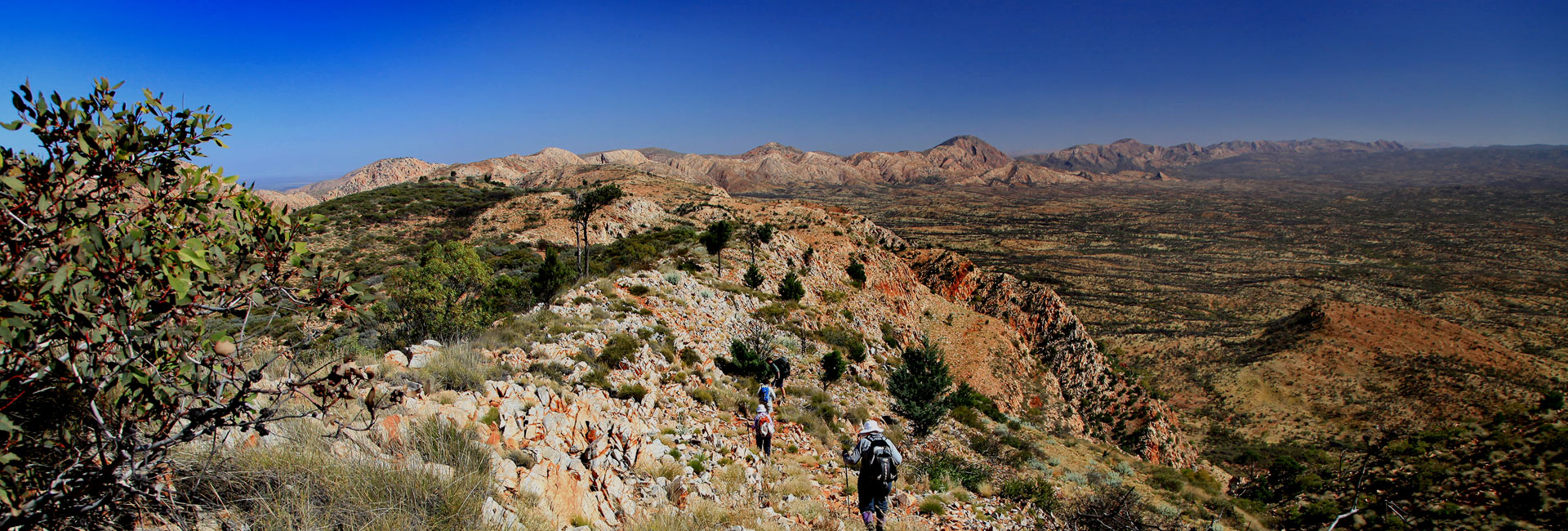Trek Larapinta Bush Life
BUSH LIFE : A Day in the Life of a Trek Larapinta Guest
Photos by David Slater (6-day guest, 2015). Story by Matt Sykes

Native Peach (Quandong) Damper, (In his recent book ‘Dark Emu’ Bruce Pascoe provides evidence that Aboriginal people were the world’s first bakers, reputedly preceding the Egyptians by thousands of years).
The concept for this week’s blog post is to experience a day in the life of a Trek Larapinta guest, with a little foodie twist. We must thank David Slater, an enthusiastic guest from last season, who was generous in making some beautiful photos available.
Trek Larapinta toes the line between the luxuries of modern “glamping” and the simplicities of traditional bush camping. Holger and Richard, the owners of the company are more inclined towards roughing it, but they well understand what guests are looking for. As a past client put it, “we didn’t want all the bells and whistles, just a few”.

“Sonder Sunrise” omelette, with Native Basil
Before we set out walking each day, we put on a good old-fashioned spread of cereal, fruit and toast for guests. There’s plunger coffee, a pot of black tea and fruit juices to match. Or in the case of the “Sonder Sunrise” (a life-changing night walk finishing with a spectacular 360° view of the desert waking up), you’ll return to an epic brunch.

Bush banana (Marsdenia australis)
When we get out on the track there might be the odd sweet bickie or lolly that jumps out of a hidden compartment in your guide’s packs. (Think Hermione Granger’s bag of tricks) But then if you’re lucky we might come across some seasonal bush food, like a bush banana for instance. Peter Latz, an expert in desert plants and their uses by Aboriginal people, explains:
‘This is an important and favoured food throughout the area [central Australia]. The only parts of the plant not eaten at some stage are the stems and fine roots. The sweet flowers and the young fruits are eaten raw, and are the most favoured portions. When mature, and consisting mainly of the seeds and their plumes, the fruits are either coked and eaten whole, or the seeds discarded and only the thick outer rind eaten in its raw state.’ (1)
When Rene Redzepi came over from Denmark to set up his pop-up restaurant NOMA Sydney, it was these unique qualities of Australian native foods that he was trying to harness. Bush coconuts are another curiosity. They commonly grow on Bloodwood (Corymbia opaca) trees after a particular insect lays its larvae and the tree is fooled by not recognising it as a foreign body. (You’ll just have to come on one of tours to hear the full story, especially the gender roles of this particular insect.) Bush coconuts have a texture similar to an oyster but with the earthy flavours of a nut.

Lunch spread in Ormiston Gorge
Just as you’re getting hungry a classic Trek Larapinta lunch spread will magically pop-up before your eyes. Some wraps and crackers, salad, cheese, tofu and sliced meat make regular appearances. And don’t worry if you’re GF (gluten free) we’ll be sure to have some rice cakes on hand. One memorable picnicking story dates back to the time that Hermannsburg Mission was in full swing, in the very late 1800s, early 1900s. A special celebration called for a week-long “picnic holiday” where the whole Mission community, over a hundred people, travelled to Palm Valley. They must have had a wonderful time because the camping adventure was repeated again several years later. Interestingly, scientists have now learnt that the Red Cabbage Palms (Livistonia mariae) of Palm Valley were transported from northern Australia sometime between 7000-30,000 years ago, reinforced by an ancient Aboriginal story that has been passed down for thousands of years. Perhaps the science of the two cultures is not so different?

The sun passes through the sky a few more degrees and its golden light starts to make the desert sparkle. Shadows lengthen and the group makes a journey back to camp. When you’ve had time to settle back in and throw on a warm layer, you end up around the campfire distilling the day’s sights, beauty and comedy. Some bickies and cheese are laid out, and a BYO glass of wine perhaps.

As darkness falls you’ll hear a shout from the kitchen that dinner’s ready. Your tummy will be grumbling after a challenging day’s walking but whatever your guide cooks up, its sure to hit the spot (Just a little tip, save room for dessert!). The night is yours to whittle away as you like, yarning around the fire or even reading a book. When the time comes you’re welcome to sleep outside in your swag, under the ancient painting of light and shadow that is the Milky Way, or retreat to your private quarters, a spacious safari tent. Good night, sleep tight.

David’s wife Helen with book in-hand, making the most of Bush Life.
References
(1) Latz, P. (2004) ‘Bushfires and Bushtucker: Aboriginal plant use in central Australia’ IAD Press, Alice Springs.
(2) Latz, P. (2014) ‘Blind Moses’ Self-published, Alice Springs.









